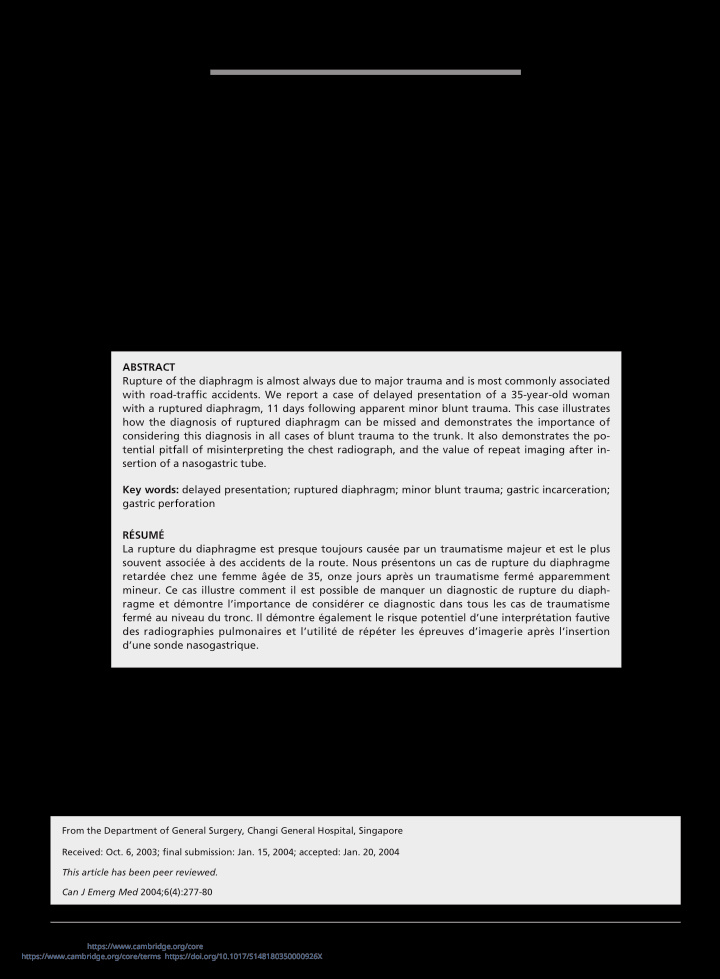



C ASE R EPORT • O BSERVATIONS DE CAS Delayed presentation of a patient with a ruptured diaphragm complicated by gastric incarceration and perforation after apparently minor blunt trauma Brian K.P. Goh, MB BS, MRCS ; Andrew S.Y. Wong, MB BS, FRCS ; Khoon-Hean Tay, MB BS, FRCS ; Michael N.Y. Hoe, MB BS, FRCS ABSTRACT Rupture of the diaphragm is almost always due to major trauma and is most commonly associated with road-traffic accidents. We report a case of delayed presentation of a 35-year-old woman with a ruptured diaphragm, 11 days following apparent minor blunt trauma. This case illustrates how the diagnosis of ruptured diaphragm can be missed and demonstrates the importance of considering this diagnosis in all cases of blunt trauma to the trunk. It also demonstrates the po- tential pitfall of misinterpreting the chest radiograph, and the value of repeat imaging after in- sertion of a nasogastric tube. Key words: delayed presentation; ruptured diaphragm; minor blunt trauma; gastric incarceration; gastric perforation RÉSUMÉ La rupture du diaphragme est presque toujours causée par un traumatisme majeur et est le plus souvent associée à des accidents de la route. Nous présentons un cas de rupture du diaphragme retardée chez une femme âgée de 35, onze jours après un traumatisme fermé apparemment mineur. Ce cas illustre comment il est possible de manquer un diagnostic de rupture du diaph- ragme et démontre l’importance de considérer ce diagnostic dans tous les cas de traumatisme fermé au niveau du tronc. Il démontre également le risque potentiel d’une interprétation fautive des radiographies pulmonaires et l’utilité de répéter les épreuves d’imagerie après l’insertion d’une sonde nasogastrique. creased with the rising number of road-traffic accidents. 2 It Background is now reported to occur in 4% of multiple-injury cases, 3 Injuries of the diaphragm were first described in 1541 by but it is extremely rare after minor trauma. We present an Sennertus. The first successful repair was performed by Ri- unusual case of delayed presentation of a patient with rup- olfi in 1886. 1 Rupture of the diaphragm due to blunt trauma ture of the diaphragm, complicated by gastric incarceration is no longer uncommon, and its incidence has steadily in- and perforation, after apparently minor blunt trauma. From the Department of General Surgery, Changi General Hospital, Singapore Received: Oct. 6, 2003; final submission: Jan. 15, 2004; accepted: Jan. 20, 2004 This article has been peer reviewed. Can J Emerg Med 2004;6(4):277-80 July • juillet 2004; 6 (4) 277 CJEM • JCMU Downloaded from https://www.cambridge.org/core. IP address: 192.151.151.66, on 09 Aug 2020 at 20:11:13, subject to the Cambridge Core terms of use, available at https://www.cambridge.org/core/terms. https://doi.org/10.1017/S148180350000926X
Goh et al Case report chest x-ray. This repeat view demonstrated left diaphrag- matic rupture with herniation of viscus into the left During a game of musical chairs at her office party, a 35- hemithorax (Fig. 2). year-old woman was accidentally kicked in her left flank She was referred to the surgical team, and an emergency and lower chest by a drunk and over-zealous colleague. celiotomy was performed. Operative findings revealed a The injury seemed minor, so she drove home and contin- 10-cm defect in the posterolateral left hemi-diaphragm, ued her usual daily activities over the next few days. How- with herniation of the stomach, greater omentum and the ever, 11 days later she developed cough, fever and sore splenic flexure of the colon into the left chest. In addition, throat, which were diagnosed as “influenza” by her family a capsular tear of the lower pole of the spleen was noted. physician. Three days later, she developed sudden onset of The abdominal contents were reduced without difficulty, vomiting and epigastric pain that radiated to the tip of her and a 5-cm diameter necrotic perforation on the anterior left shoulder. The pain did not resolve over the next 3 days, wall of the body of the stomach was found. The diaphragm and she was referred by her family physician to the emer- was repaired, and a Polya partial gastrectomy was per- gency department (ED). formed because the necrotic gastric perforation was too On arrival, the patient was alert but dyspneic, with a large to close primarily. The injury to the spleen was man- respiratory rate of 33 breaths/min and an oxygen satura- aged conservatively. Her postoperative recovery was un- tion of 95%. She was hemodynamically stable but febrile, eventful, and she was well on follow-up. with a temperature of 39°C. Auscultation revealed de- Discussion creased air entry in the left chest and mild epigastric ten- derness. The initial chest radiograph performed in the ED was interpreted as showing a loculated left pneumothorax Rupture of the diaphragm after blunt trauma is relatively (Fig. 1), and she was admitted to the respiratory unit. For- uncommon, occurring in approximately 0.8%–1.6% of patients who are hospitalized with blunt trauma. 4 It usu- tunately, before tube thoracostomy, an astute respiratory physician inserted a nasogastric tube and repeated the ally occurs in patients involved in major road-traffic acci- Fig. 2. Chest radiograph after nasogastric tube insertion Fig. 1. First chest radiograph, results of which were inter- clearly showing left diaphragmatic rupture with gastric her- preted as a loculated left pneumothorax. niation. 278 July • juillet 2004; 6 (4) CJEM • JCMU Downloaded from https://www.cambridge.org/core. IP address: 192.151.151.66, on 09 Aug 2020 at 20:11:13, subject to the Cambridge Core terms of use, available at https://www.cambridge.org/core/terms. https://doi.org/10.1017/S148180350000926X
Recommend
More recommend